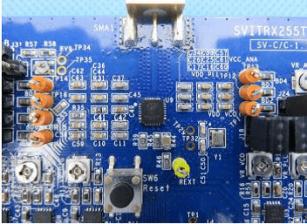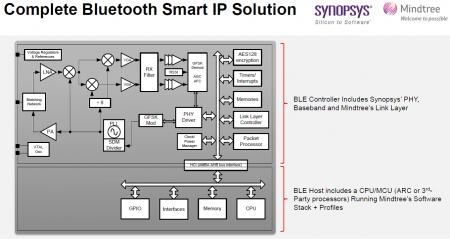Synopsys launch BTLE PHY IP, qualified by the Bluetooth Special Interest Group (SIG) and meeting compliance with the Bluetooth® Smart v4.2 specification. The company has built a partnership with Mindtree to provide a complete solution, integrating Synopsys’ Bluetooth Smart PHY IP and Mindtree’s production-proven BlueLitE link layer and software stack IP. The PHY IP has been developed on TSMC 55nm (and 180 nm) and is currently ported on TSMC 40 nm. Synopsys’ marketers think that the semiconductor content of IoT edge systems like wearable, beacons, fitness or health should be low cost to see a strong adoption. By low cost, they mean a few dollars and definitely less than 5$ for the semiconductor content.
But the selected technology node (55 nm) also means relatively low development cost, at least much, much lower than on 28 or even 22 nm. Here we have to remember the low complexity of an IoT edge device: a sensor providing a small amount of data to a MCU, once processed the data to be wirelessly transmitted via on-chip BTLE protocol to the gateway. You simply don’t want to target an aggressive technology node and invest a huge amount of money in development cost for such a relatively simple system, comparable to a 2$ MCU in term of complexity.

This Bluetooth PHY IP, designed for IoT battery powered application, operates below one volt supply to extend battery life and there is no need to target advanced technology nodes to save power. If you expect IoT devices count to reach analysts’ forecast, then the inferred proposal is that the development cost should be reasonable enough so we can see a multiplicity of IoT systems coming to the market. That’s why I think that offering IP targeting 55nm rather than 28nm, allowing much cheaper NRE design cost, sounds like cleaver market positioning… and common sense.
Device cost and power consumption, efficient wireless connection, these should be the main features for a successful IoT edge device. Synopsys’ Bluetooth smart PHY IP with Mindtree’s Link Layer and Software Stack IP is a complete, production proven solution. Mindtree brings a software part which consists of all the mandatory and optional features of the Bluetooth Smart core stack and all the adopted profiles. Synopsys’ PHY IP including an integrated on-chip transceiver matching network and single pin-to-antenna interface helps reducing reduce BOM cost and simplify board design. By definition, a wired or wireless connectivity IP has to be interoperable. The IP conformance to BLE 4.2 has been validated and all tests “Pass” in corner conditions for an operating voltage in the 0.95V ~ 1.2V range and operating temperature from -40C to 85C. How to make sure that an IP has been qualified? Just take a look at the Bluetooth Qualified Design Listing (QDL) and check for:


To address IoT design requirements, Synopsys propose a specific IP portfolio and take special care to support:
- Connectivity
- Security
- Energy efficiency
- Sensor processing
Synopsys had to make major investments in expanding portfolio, like for this Bluetooth PHY IP coming from the acquisition of Silicon Vision assets, or by re-architecting existing IP for IoT, optimized for low power consumption and for 55-nm and 40-nm IoT process technologies. This IP portfolio counts wireless, security (accelerators and security modules), interfaces (USB, MIPI DSI & CSI, Ethernet, ADC…), memories (EPROM, ROM, RAM and VNM), logic libraries, processors (ARC and vision processors) and sensors and control subsystems.
What’s the next step to develop IoT edge system even more cost and footprint optimized? When the sensor itself will be integrated into the IoT SoC, the edge system cost, footprint and power consumption should reach a minimum. This integration path can be valid, but only if the target SoC technology node allows to support sensor integration. I am not sure that it will be the case for 28-nm or below…
From Eric Esteve from IPNEST
More about Bluetooth smart IP from Synopsys:
- Press Release: Synopsys and Mindtree Collaborate to Deliver Complete Bluetooth Smart IP Solution for IoT SoCs
- Webinar: Synopsys and TSMC Get Smart with Bluetooth for IoT SoCs
- Web Page: DesignWare Bluetooth Smart IP
- Datasheet: Bluetooth Smart PHY IP for TSMC 55nm Process







Comments
0 Replies to “Is Smart Bluetooth de facto standard for IoT Wearable, Beacons, Fitness and Health ?”
You must register or log in to view/post comments.